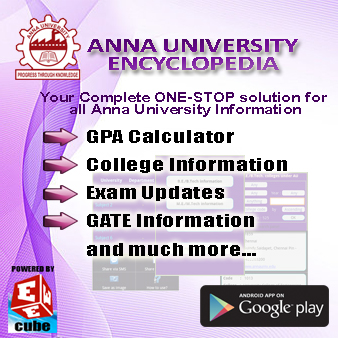SUBJECT RESOURCES:
CLICK HERE to access 'Question Banks'
CLICK HERE to access 'Previous Year Question Papers'
CLICK HERE to access 'Notes'
CLICK HERE to access '2 Marks'
CLICK HERE to search more about this subject
SYLLABUS:
CLICK HERE to access 'Question Banks'
CLICK HERE to access 'Previous Year Question Papers'
CLICK HERE to access 'Notes'
CLICK HERE to access '2 Marks'
CLICK HERE to search more about this subject
SYLLABUS:
EE2024 BIOMEDICAL INSTRUMENTATION L T P C
3 0 0 3
AIM:
The course is
designed to make the student acquire an adequate knowledge of the physiological systems of the human body and relate them to the parameters that have clinical importance.
The fundamental principles of equipment that are actually in use at the present day are introduced.
OBJECTIVES:
i. To provide an acquaintance of the physiology of the heart, lung, blood circulation and circulation respiration. Biomedical applications of different transducers used.
ii. To introduce the student to the various sensing and measurement devices of electrical origin. To provide awareness of electrical safety of medical
equipments
iii. To provide the latest ideas on devices of non-electrical
devices.
iv. To bring out the important and modern methods of imaging techniques.
v. To provide latest knowledge of medical assistance / techniques and therapeutic
equipments.
UNIT I PHYSIOLOGY AND TRANSDUCERS 9
Cell and its structure – Resting and Action Potential – Nervous system: Functional organisation of
the nervous system
– Structure of nervous system, neurons - synapse –transmitters and neural
communication – Cardiovascular system
– respiratory system
– Basic components of a biomedical
system - Transducers – selection criteria – Piezo electric, ultrasonic
transducers - Temperature measurements - Fibre optic temperature sensors.
UNIT II ELECTRO – PHYSIOLOGICAL MEASUREMENTS 9
Electrodes –Limb electrodes –floating electrodes – pregelled disposable electrodes
- Micro, needle
and surface electrodes – Amplifiers: Preamplifiers, differential amplifiers, chopper amplifiers – Isolation amplifier.
ECG – EEG – EMG – ERG – Lead systems and recording methods – Typical waveforms.
Electrical safety in medical
environment: shock hazards – leakage current-Instruments for checking
safety parameters of biomedical
equipments
UNIT III NON-ELECTRICAL PARAMETER MEASUREMENTS 9
Measurement of blood pressure – Cardiac
output – Heart rate – Heart sound –Pulmonary
function
measurements – spirometer – Photo Plethysmography, Body Plethysmography – Blood Gas
analysers
:
pH of blood –measurement of
blood pCO2, pO2, finger-tip oxymeter - ESR,
GSR measurements .
UNIT IV MEDICAL IMAGING 9
Radio graphic and fluoroscopic techniques – Computer tomography – MRI – Ultrasonography
– Endoscopy – Thermography – Different types of biotelemetry systems and patient monitoring – Introduction to Biometric systems
UNIT V ASSISTING AND THERAPEUTIC EQUIPMENTS 9
Pacemakers – Defibrillators – Ventilators – Nerve and muscle stimulators – Diathermy – Heart –
Lung machine – Audio meters – Dialysers – Lithotripsy
TOTAL : 45 PERIODS
TEXT BOOKS
1. R.S.Khandpur, ‘Hand Book of Bio-Medical instrumentation’, Tata McGraw Hill Publishing Co Ltd.,
2003.
2. Leslie Cromwell, Fred J.Weibell, Erich A.Pfeiffer, ‘Bio-Medical Instrumentation and
Measurements’, II edition, Pearson Education, 2002 / PHI.
REFERENCES
1. M.Arumugam, ‘Bio-Medical Instrumentation’, Anuradha Agencies, 2003.
2. L.A. Geddes and L.E.Baker, ‘Principles of Applied Bio-Medical Instrumentation’, John Wiley &
Sons, 1975.
3. J.Webster, ‘Medical Instrumentation’, John Wiley & Sons, 1995.
4. C.Rajarao and S.K. Guha, ‘Principles of Medical Electronics and Bio-medical Instrumentation’, Universities press (India) Ltd, Orient Longman ltd, 2000.
|
|











this is really nice:):) happy to get two marks and question bank here
ReplyDelete